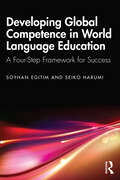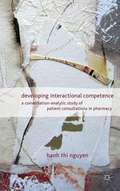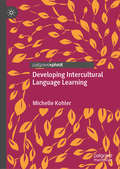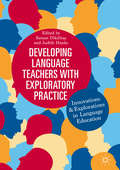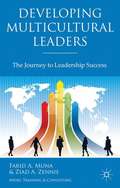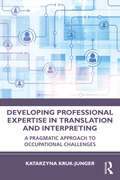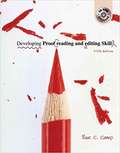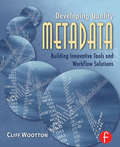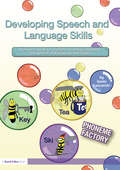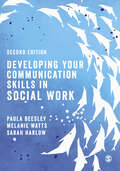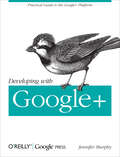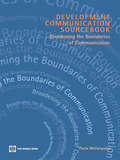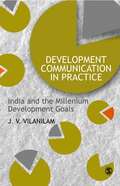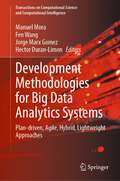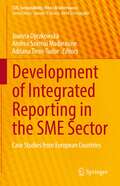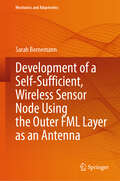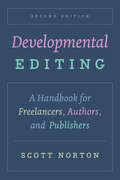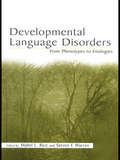- Table View
- List View
Developing Global Competence in World Language Education: A Four-Step Framework for Success
by Soyhan Egitim Seiko HarumiThis book presents a four-step framework to help English as a world language (EWL) learners successfully develop global competence, which is defined as the skills, values, and behaviors that prepare young people to thrive in diverse environments. The book showcases practical methods and strategies supported by autoethnography and empirical studies to detail the four elements of the framework towards developing global competence: English language proficiency, cross-cultural knowledge, adopting flexibility in oral communication, and embracing values beyond our horizons. While the English language and culture provide essential input for effective communication, developing flexibility in communication styles and viewing conflict as an opportunity for growth can help L2 learners navigate intercultural encounters more effectively and achieve cross-cultural adaptation. This text will be beneficial to language learners, intercultural communication majors, researchers, and educators in TESOL/EFL/ESL programs, as well as in-service teachers of English language learners (ELLs).
Developing Healthy Relationships: A Guide for Singles
by Jeff ParzialeWhat is holding you back from a healthy deeply fulfilling relationship?
Developing Interactional Competence
by Hanh Thi NguyenAn unprecedented glimpse into the multidimensional learning processes that take place when novice professionals develop the necessary communication skills for effective task accomplishment. This analysis of authentic patient consultations by pharmacy interns is a significant contribution to research on health communication training.
Developing Intercultural Language Learning
by Michelle KohlerThis book presents a detailed account of a self-study in which the author considers why a developmental perspective matters in language learning within an intercultural orientation, and how teachers of languages might understand and attend to this notion in their work. The discussion is based on the author’s experience as a teacher-researcher and traces aspects of teachers’ work from planning, teaching and mediating, to assessing and judging evidence of student learning and development over time. This book is grounded in a praxis view of language teaching and learning and will be of interest to other language teachers, pre-service teachers, teacher trainers and applied linguists.
Developing Language Teachers with Exploratory Practice: Innovations and Explorations in Language Education
by Judith Hanks Kenan DikilitaşThis edited collection explores the use of Exploratory Practice (EP) by language teachers in classrooms. Written by practitioners, the chapters showcase unique examples of each principle of EP, with topics ranging from mentoring practitioner researchers, to teaching and learning in EAP, and investigating curriculum development in language teaching programs. The book provides example EP studies and gives voice to practitioners’ experiences of the challenges they experienced as well as the benefits. Examples include tackling intercultural communication in linguistically and culturally diverse classrooms; pedagogy and curriculum design in language teaching; explorations of continuing professional development in language education. In doing so, it offers tools that can be transferred to other classroom contexts and used to aid teacher development. The concluding chapter highlights critical aspects of Exploratory Practice which emerge in the studies and examines how practitioners advanced their understandings. This book will appeal to those working in Applied Linguistics, TESOL research, as well as language teachers and teacher educators.
Developing Language and Communication Skills through Effective Small Group Work: SPIRALS: From 3-8
by Marion Nash Jackie Lowe Tracey PalmerFirst published in 2011. Routledge is an imprint of Taylor & Francis, an informa company.
Developing Microsoft® SharePoint® Applications Using Windows Azure™
by Steve FoxYour expert guide to building Microsoft® SharePoint® applications in the cloud Deliver custom, cloud-based business solutions using SharePoint 2010 and Windows AzureTM together. By applying hands-on techniques from Microsoft cloud development expert Steve Fox, you'll learn how to increase the reach, resource capability, and reusability of your apps. Get the practical code exercises and solid advice you need--whether you're planning to build complete data-driven applications or hybrid solutions with simple Web parts. Discover how to: Deliver data from Windows Azure Marketplace DataMarket into SharePoint and Microsoft Office applications Use Microsoft Business Connectivity Services to connect to SQL AzureTM data Create advanced web parts to surface SQL Azure data in BingTM Maps, using the SharePoint client object model Manage files in Windows Azure using BLOB storage Deploy Windows Communication Foundation (WCF) services to Windows Azure Build business intelligence solutions, using SQL Azure, Microsoft SQL Server® Reporting Services (SSRS) Get code samples on the web Ready to download at http://go.microsoft.com/FWLink/?Linkid=0 00000. For system requirements, see the Introduction.
Developing Multicultural Leaders
by Farid A. Muna Ziad A. ZennieThe authors identify three stages of leadership development - the early ingredients for success starting from childhood, the paths that current and aspiring leaders should follow once they start a career, and what leaders should do exceptionally well to become and remain outstanding in organizations operating in multicultural environments.
Developing Multicultural Leaders
by Farid A. Muna Ziad A. ZennieThe authors identify three stages of leadership development: the early ingredients for success starting from childhood; the paths that current and aspiring leaders should follow once they start a career; and what leaders should do exceptionally well to become and remain outstanding in organizations operating in multicultural environments.
Developing Professional Expertise in Translation and Interpreting: A Pragmatic Approach to Occupational Challenges
by Katarzyna Kruk-JungerDeveloping Professional Expertise in Translation and Interpreting covers what professional expertise means for translators and interpreters in the fast-changing, globalised world and how it can be achieved in practice.The book offers tactics and solutions for everyday issues, such as competence, etiquette, cultural differences, the translator’s role in communication, dealing with mistakes and using new technologies, using real-life examples of the occupational challenges practitioners face in their line of work. These range from translating Donald Trump’s controversial political tweets or interpreting during Oscar Pistorius’ high-profile court trial.This user-friendly guide helps students in translator training, or professionals starting out as translators and interpreters, establish good working standards and offers pragmatic solutions to common professional dilemmas for more experienced translators and interpreters.This is also an ideal resource for professors creating curricula in the area of ethics and etiquette within translation and interpreting, offering an interdisciplinary approach and an overview of the literature regarding all key topics.
Developing Proofreading And Editing Skills
by Sue C. CampDeveloping Proofreading and Editing Skills, 5/e by Camp provides instruction and applications designed to sharpen skills in detecting and correcting errors in written communications including memos, letters, reports, email messages, databases, presentation slides, advertisements, and spreadsheets. The material progresses from easy-to-recognize errors to those more difficult to spot, allowing students to build confidence and skill. Highlights of the 5th edition include a discussion of voice-recognition technology and proofreading and editing, end-of-chapter text applications with two applications in each chapter available on CD-ROM, and a series of seven review modules offering challenging proofreading practice.
Developing Quality Metadata: Building Innovative Tools and Workflow Solutions
by Cliff WoottonWith the explosion of new audio and video content on the Web, it's more important than ever to use accurate and comprehensive metadata to get the most out of that content. Developing Quality Metadata is an advanced user guide that will help you improve your metadata by making it accurate and coherent with your own solutions. This book is designed to get you thinking about solving problems in a proactive and productive way by including practical descriptions of powerful programming tools and user techniques using several programming languages. For example, you can use shell scripting as part of the graphic arts and media production process, or you can use a popular spreadsheet application to drive your workflow. The concepts explored in this book are framed within the context of a multimedia professional working on the Web or in broadcasting, but they are relevant to anyone responsible for a growing library of content, be it audio-visual, text, or financial.
Developing Speech and Language Skills: Phoneme Factory
by Gwen LancasterThis book is part of the Phoneme Factory Project undertaken by Granada Learning in partnership with the Speech and Language Therapy Research Unit (SLTRU) in Bristol. It aims to provide guidance for teachers, SENCos, SLTs and parents regarding: criteria for referral to speech and language therapy phonological disorders appropriate intervention approaches that can be used in the classroom and at home. Complementing the book is a CD containing downloadable resources including a picture library for the classroom and the home, as well as checklists and other time-saving documents.
Developing Your Communication Skills in Social Work
by Paula Beesley Melanie Watts Sarah HarlowThis book explores: · What is meant by communication skills · What communication skills are · What they look like in practice · The differences in communicating with service users and professionals, such as children, guardians, peers and emergency workers · Why they are important It includes a wide range of theories, multiple case studies, reflective tasks, and exercises. It will develop your critical thinking and reflection skills, and help you develop your own communication style. Presented in a chronological style which acts as a working tool that you can dip into and out of. Each chapter is structured in a way that encourages you to build on your knowledge, so it begins by taking you right back to basics to learn core theory and practice techniques before getting you to critically reflect on the use of different skills in different settings and with different service user groups. The end-of-chapter skills audits help you to reflect on what you have learnt, what your strengths are and what you need to work on more.
Developing Your Communication Skills in Social Work
by Paula Beesley Melanie Watts Sarah HarlowThis book explores: · What is meant by communication skills · What communication skills are · What they look like in practice · The differences in communicating with service users and professionals, such as children, guardians, peers and emergency workers · Why they are important It includes a wide range of theories, multiple case studies, reflective tasks, and exercises. It will develop your critical thinking and reflection skills, and help you develop your own communication style. Presented in a chronological style which acts as a working tool that you can dip into and out of. Each chapter is structured in a way that encourages you to build on your knowledge, so it begins by taking you right back to basics to learn core theory and practice techniques before getting you to critically reflect on the use of different skills in different settings and with different service user groups. The end-of-chapter skills audits help you to reflect on what you have learnt, what your strengths are and what you need to work on more.
Developing the Public Relations Campaign: A Team-Based Approach (3rd Edition)
by Randy Bobbitt Ruth Sullivan<p>Written for students taking advanced courses in public relations, the book takes a team project approach to learning about the field. The book introduces a three-step process—the PIE chart—that more accurately reflects the campaign development process used in the real world. Exercises and case studies in every chapter guide students through the development of their own public relations campaigns. <p> <p>Upon completing this book, readers will be able to: <p> <li>Develop their own public relations campaigns <li>Apply public relations skills to the real world <li>Understand how to apply communication theories to public relations</li>
Developing with Google+: Practical Guide to the Google+ Platform
by Jennifer MurphyWould you like to integrate Google+ with an existing website, or build your own social application on the platform? Developing with Google+ takes you on a tour of the Google+ APIs, with lots of concrete examples and hands-on projects. You’ll learn how to take advantage of Google+ social plug-ins, communicate programmatically with Google+ over REST APIs, and author real-time Hangout Apps.Over the course of this book, you’ll follow the progress of a fictional company, Baking Disasters, as it incorporates all the features of the Google+ platform.Make the most of social widgets such as the +1 button, Badge, and the Share buttonUse performance tuning techniques to speed up social plugins on your siteCreate your own plugins by accessing public data APIs with RESTful web servicesTransform an blog into a social web application through server-side processingUse OAuth to authenticate users and authorize your access to their private dataExtend Google+ Hangouts programmatically and create your own application
Development Communication Sourcebook
by Paolo MefalopulosThe 'Development Communication Sourcebook' highlights how the scope and application of communication in the development context are broadening to include a more dialogic approach. This approach facilitates assessment of risks and opportunities, prevents problems and conflicts, and enhances the results and sustainability of projects when implemented at the very beginning of an initiative. The book presents basic concepts and explains key challenges faced in daily practice. Each of the four modules is self-contained, with examples, toolboxes, and more.
Development Communication in Practice: India and the Millennium Development Goals
by J V VilanilamThis book takes a fresh look at development communication in the Indian context. Charting its international history and discussing the Millennium Development Goals (MDGs) that evolved as part of the phenomenon of globalization, it links the history of India′s development with development communication and discusses the role of media in disseminating information to the public. Development Communication in Practice: India and the Millennium Development Goals analyzes seven Indian newspapers for a period of seven months and evaluates the extent to which development issues are addressed in them. The findings reveal an under-representation of development issues in the media which, the author argues, needs to be addressed. Reviewing recent concepts on poverty measurement and the MDGs set forth by global scholars such as Jagdish Bhagwati, Amartya Sen and Joseph Stiglitz, the book acknowledges the importance of information technology, literacy and education in the process of development. This book will be a good resource for economists, development communication practitioners, government officials dealing in media and communication and students and researchers working in the fields of communication and media studies and journalism.
Development Methodologies for Big Data Analytics Systems: Plan-driven, Agile, Hybrid, Lightweight Approaches (Transactions on Computational Science and Computational Intelligence)
by Manuel Mora Jorge Marx Gomez Fen Wang Hector Duran-LimonThis book presents research in big data analytics (BDA) for business of all sizes. The authors analyze problems presented in the application of BDA in some businesses through the study of development methodologies based on the three approaches – 1) plan-driven, 2) agile and 3) hybrid lightweight. The authors first describe BDA systems and how they emerged with the convergence of Statistics, Computer Science, and Business Intelligent Analytics with the practical aim to provide concepts, models, methods and tools required for exploiting the wide variety, volume, and velocity of available business internal and external data - i.e. Big Data – and provide decision-making value to decision-makers. The book presents high-quality conceptual and empirical research-oriented chapters on plan-driven, agile, and hybrid lightweight development methodologies and relevant supporting topics for BDA systems suitable to be used for large-, medium-, and small-sized business organizations.
Development of Integrated Reporting in the SME Sector: Case Studies from European Countries (CSR, Sustainability, Ethics & Governance)
by Joanna Dyczkowska Andrea Szirmai Madarasine Adriana Tiron-TudorThis book examines on an international basis how small and medium-sized enterprises (SMEs) cope with the changing economic and social challenges, which are also reflected in financial and non-financial reporting. To this end, it presents six case studies from Germany, Hungary, Romania, Poland, Italy, and the United Kingdom, with a particular focus on integrated reporting (IR). The cases presented are drawn from collaborative research within the international network of INTEREST, an international project on integrated reporting for SME transparency. The book will be of interest to researchers and practitioners.
Development of a Self-Sufficient, Wireless Sensor Node Using the Outer FML Layer as an Antenna (Mechanics and Adaptronics)
by Sarah BornemannThis book presents an investigation on integrating wireless sensor nodes including their antennas into fiber metal laminates (FMLs) for the purpose of enabling wireless, material-integrated structural health monitoring. Within the scope of this work, a digital sensor node is presented, which can be fully integrated into a conductive host material. A stainless steel antenna supplies the system with sufficient power to provide the functions required for its intended use. This system enables the wireless readout of sensor data for the detection of damage in FMLs. The application focuses on aerospace components, for the detection of damage in the inner material layers, which are not or only hardly detectable by optical inspection methods. Guided ultrasonic waves in the form of Lamb waves are used for this. The flexible electronics are inserted into the layers of the target material, while the associated antenna is cut into the outer metal layer. This turns the outer metal layer, which would prevent wireless communication from inside the laminate, into an advantage, as the need for an additional, external antenna is eliminated. Two fundamentally different principles can be used as the sensor element. Piezoelectric sensors were already used extensively in structural health monitoring using ultrasound and recently developed piezoresistive sensors, which are designed to be very small, making them highly suitable for material integration. Both types of sensors can be read out with the presented system so that the most appropriate approach can be chosen depending on the application. The suitability of the wireless sensor system for its intended purpose is verified by material-integrated measurements. At the end of this work, it is shown that the raw data of the measurements reproducibly provide a sufficient resolution of the sensor signal to manually identify changes caused by applied reversible, artificial pseudo-defects from reference measurements without any damage. The intended audience of this book are people from the field which are familiar with the basic concepts of electrical engineering or similar regions, embedded system enthusiasts and all readers who like to follow the process of a complete wireless electronic system design from requirements analysis to final material-integrated measurement demonstrations.
Developmental Editing, Second Edition: A Handbook for Freelancers, Authors, and Publishers (Chicago Guides to Writing, Editing, and Publishing)
by Scott NortonThe only guide dedicated solely to developmental editing, now revised and updated with new exercises and a chapter on fiction. Developmental editing—transforming a manuscript into a book that edifies, inspires, and sells—is a special skill, and Scott Norton is one of the best at it. With more than three decades of experience in the field, Norton offers his expert advice on how to approach the task of diagnosing and fixing structural problems with book manuscripts in consultation with authors and publishers. He illustrates these principles through a series of detailed case studies featuring before-and-after tables of contents, samples of edited text, and other materials to make an otherwise invisible process tangible. This revised edition for the first time includes exercises that allow readers to edit sample materials and compare their work with that of an experienced professional as well as a new chapter on the unique challenges of editing fiction. In addition, it features expanded coverage of freelance business arrangements, self-published authors, e-books, content marketing, and more. Whether you are an aspiring or experienced developmental editor or an author who works alongside one, you will benefit from Norton’s accessible, collaborative, and realistic approach and guidance. This handbook offers the concrete and essential tools it takes to help books to find their voice and their audience.
Developmental Editing: A Handbook for Freelancers, Authors, and Publishers (Chicago Guides To Writing, Editing, And Ser.)
by Scott NortonThe only guide dedicated solely to developmental editing, now revised and updated with new exercises and a chapter on fiction. Developmental editing—transforming a manuscript into a book that edifies, inspires, and sells—is a special skill, and Scott Norton is one of the best at it. With more than three decades of experience in the field, Norton offers his expert advice on how to approach the task of diagnosing and fixing structural problems with book manuscripts in consultation with authors and publishers. He illustrates these principles through a series of detailed case studies featuring before-and-after tables of contents, samples of edited text, and other materials to make an otherwise invisible process tangible. This revised edition for the first time includes exercises that allow readers to edit sample materials and compare their work with that of an experienced professional as well as a new chapter on the unique challenges of editing fiction. In addition, it features expanded coverage of freelance business arrangements, self-published authors, e-books, content marketing, and more. Whether you are an aspiring or experienced developmental editor or an author who works alongside one, you will benefit from Norton’s accessible, collaborative, and realistic approach and guidance. This handbook offers the concrete and essential tools it takes to help books to find their voice and their audience.
Developmental Language Disorders: From Phenotypes to Etiologies
by Mabel L. Rice Steven F. WarrenDevelopmental Language Disorders: From Phenotypes to Etiologies is based on the recent conference of the same name sponsored by the Merrill Advanced Studies Center of the University of Kansas. In the past 10 years, considerable advances have taken place in our understanding of genetic and environmental influences on language disorders in children. Significant research in behavioral phenotypes, associated neurocortical processes, and the genetics of language disorders has laid the foundation for further breakthroughs in understanding the reasons for overlapping etiologies, as well as the unique aspects of some phenotypes. Too often the findings are disseminated in a fragmented way because of the discrete diagnostic categories of affectedness. This volume attempts to assimilate and integrate the findings of the transdisciplinary research toward a more coherent picture of behavioral descriptions, brain imaging studies, genetics, and intervention technologies in language impairment. The contributing authors are all scholars with active programs of research funded by the National Institutes of Health involving diverse clinical groups of children with language impairments.
